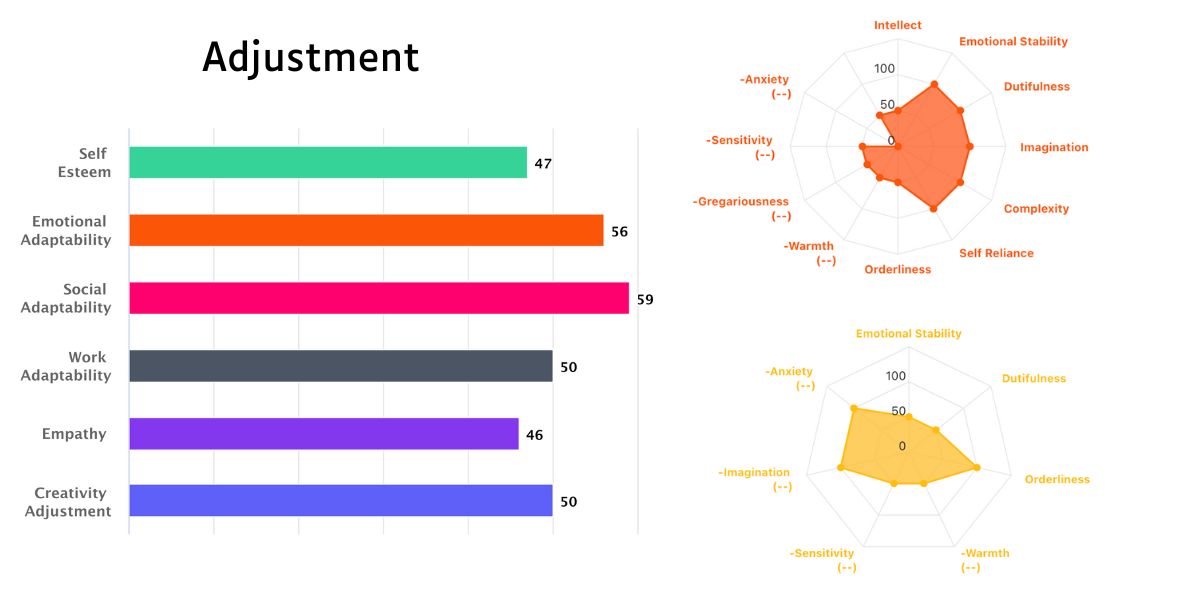The Adjustment Blueprint: Enhancing Your Adaptability Strategy
 Be it a career change, ending a relationship or some global uncertainty, everything keeps changing. It is fascinating how everyone responds differently to the fact that change is a constant. Some are graceful while others feel like they have been thrown overboard. In reality, what factors determine your ability to adapt towards change?
Be it a career change, ending a relationship or some global uncertainty, everything keeps changing. It is fascinating how everyone responds differently to the fact that change is a constant. Some are graceful while others feel like they have been thrown overboard. In reality, what factors determine your ability to adapt towards change?
This process, known in psychology as adjustment involves cultivating adaptability and resilience to thrive amidst change.
At Personality HQ, we have created a psychometric model called the Adjustment Indices, which is a six-level structure that attempts to evaluate an individual’s adaptation to emotional pressure, social changes, and professional unpredictability. Before delving into the framework, let us shift our focus towards the underlying architecture that enables effective coping strategies towards change.
Adapting Through the Lens of Culture and Context
You do not adapt in a vacuum. Cultural background and socioeconomic context factors greatly influence how one interprets and reacts to change. For instance, member of collectivist cultures tend to rely on community and family support systems which act as a buffer against stress. In contrast, individualistic societies place more emphasis on personal control and self-efficacy, resilience is built through different pathways psychological.
Additionally, the availability of mental health services, education, and social welfare can affect adaptability to change. Those without resources may rely more on community networks while those with access to institutions may turn to therapy or use structured interventions. Understanding these nuances is essential. Adaptability is not flexible.
The Six Pillars of Psychological Flexibility
Adjustability isn’t simply one attribute; instead, it’s a complex adjustment of many inner traits working collectively, which we call the adjustment indices. Thus, we can define it with great specificity with the help of:
-
Self-Esteem: The confidence someone has on him/her self that enables him/her to cope with weak situations.
-
Emotional Adaptability: Your ability to stay flexible, grounded, and open in the face of emotional turbulence.
-
Social Adaptability: How easily you adjust to shifting social landscapes—whether that’s new friendships, workplaces, or family dynamics.
-
Work adaptability: This shows how a worker maneuvers himself with the new job responsibilities, abilities and with any changes in the scope of position.
-
Empathy: As any caring, feeling or concern that is directed towards another human being who is suffering.
-
Creativity adjustment: This means looking at a problem as a storyteller, through colorful, fresh and vivid lenses devoid of predefined solutions that make it reframing a problem.
All these are very pragmatic components of petronas lifestyle and not only possible but also develop them through experiences, thus forming real habits instead of merely personality traits.
Measuring What Matters: How We Assess Adaptability
It is hard to assess adaptability with a singular survey that lacks depth. Part of the versatility in dimensionality reduction lies in its multitude of perspectives. And unlike most who promise solutions, we focus on flexibility instead of relying on rigid depiction of snapshots.
Not All Resilience Looks the Same: Three Adaptation Styles
People do stress in different ways. In fact, researchers have identified three techniques which people adapt to:
-
Resilient: This category indicates someon who experience disruption at a minimal level. Their mood and functioning is fairly retained.
-
Recovering: This group suffers a dip during difficult periods but eventually rebounds after rearranging themselves followed by reflection.
-
Resistant: This group experiences chronically high levels of stress which makes it hard to regain balance for prolonged periods.
What distinguishes these pathways arises not only from an individual's character. The resources and coping mechanisms at hand are equally important. With reframing the challenge as cognitive disengagement, or addressing active problem-solving aid the individual to recover or shift from the range of 'resistant'.
Resilience in Practice
While the theories in range are essential, tangible illustrations have higher value. One such example includes school based project during which professionals assisted students with exploration of goals and other career related milestones. Students self-reported improved confidence.
Your Adjustment Journey Begin
Adaptability isn’t something you either have or don’t, it’s something you build. The good news? The six Adjustment Indices give you a map. Whether you’re navigating a breakup, job loss, or just the general chaos of life, you can find your footing again.
Start by getting curious about where you’re strong and where you need support. At Personality HQ, we’ve created an assessment that helps you do just that.
Start with this Personality test
In less than 10 minutes, you’ll see which areas of your resilience are thriving and where you can grow.
Other Posts:
How Self-Expression Improves Your Workplace Communication ›
‹ The Personality Test Trusted by 8 Million Minds